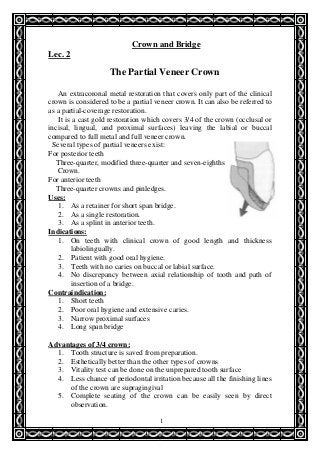
55187683 partial-veneer-crown
- 1. 1 Crown and Bridge Lec. 2 The Partial Veneer Crown An extracoronal metal restoration that covers only part of the clinical crown is considered to be a partial veneer crown. It can also be referred to as a partial-coverage restoration. It is a cast gold restoration which covers 3/4 of the crown (occlusal or incisal, lingual, and proximal surfaces) leaving the labial or buccal compared to full metal and full veneer crown. Several types of partial veneers exist: For posterior teeth Three-quarter, modified three-quarter and seven-eighths Crown. For anterior teeth Three-quarter crowns and pinledges. Uses: 1. As a retainer for short span bridge. 2. As a single restoration. 3. As a splint in anterior teeth. Indications: 1. On teeth with clinical crown of good length and thickness labiolingually. 2. Patient with good oral hygiene. 3. Teeth with no caries on buccal or labial surface. 4. No discrepancy between axial relationship of tooth and path of insertion of a bridge. Contraindication: 1. Short teeth 2. Poor oral hygiene and extensive caries. 3. Narrow proximal surfaces 4. Long span bridge Advantages of 3/4 crown: 1. Tooth structure is saved from preparation. 2. Esthetically better than the other types of crowns 3. Vitality test can be done on the unprepared tooth surface 4. Less chance of periodontal irritation because all the finishing lines of the crown are supragingival 5. Complete seating of the crown can be easily seen by direct observation.
- 2. 2 Disadvantages: 1. Difficulty in preparation compared to other types of crowns 2. There is more possibility of recurrent caries along the cavosurface line angle 3. There is a possibility of showing metal especially in the lower anterior and posterior teeth Preparation of 3/4 crown on anterior teeth The finishing lines in all the prepared surfaces are chamfer finishing lines 1. Lingual reducion: This is done by two steps similar to the other types of crowns. a)Cingulum portion b) Lingual fossa portion 2. Incisal reduction : For the maxillary anterior teeth a lingual-incisal bevel is placed using a diamond bur at 35 to the lingual surface. This preparation should not be extended labially to prevent showing of gold. For the lower anterior teeth, a reverse bevel is placed on the labial surface to cover the incisal edge in order to protect the area of unsupported enamel from fracture and prevent the dislodgement of the crown. 3. Proximal reduction: The area is prepared similar to the full metal and full veneer crown but care should be taken to avoid opening the contact to the labial surface. Two proximal grooves should be placed parallel to the incisal 2/3 of the labial surface using a carbide fissure bur to get the longest groove for better retention and to avoid overcutting to the labial surface resulting in poor esthetic. The grooves should be placed at the junction of the labial and middle third of the proximal surface and parallel to each other. The base of the groove should be 0.5 mm. above the chamfer finishing line. Labial to the grooves the finishing line should be made with a flare to permit easy burnishing of the crown margin. The mesial and distal grooves should be connected with an incisal offset. The advantage of the incisal offset is the
- 3. 3 improvement of the strength of crown at this area and reinforcement of margin by connecting the two proximal grooves together. Differences between anterior and posterior teeth preparation In the anterior teeth the retentive proximal groove should be parallel to the incisal 2/3 of the labial surface while in the posterior teeth it is parallel to long axis to get the longest groove for better retention of crown. Differences in the preparation of maxillary and mandibuar posterior teeth 1. The occlusal finishing line of the maxillary teeth terminate near the bucco-occlusal junction while in the mandibular teeth the finishing line is 1 mm. gingival to the lowest occlusal contact with the upper teeth because the buccal cusp in lower teeth is a functional cusp which should be covered by gold. 2. In the maxillary teeth there should be an offset, while in the mandibular teeth there is no offset but there is a bucco- occlusal shoulder (more reduction).
- 4. This document was created with Win2PDF available at http://www.win2pdf.com. The unregistered version of Win2PDF is for evaluation or non-commercial use only. This page will not be added after purchasing Win2PDF.
